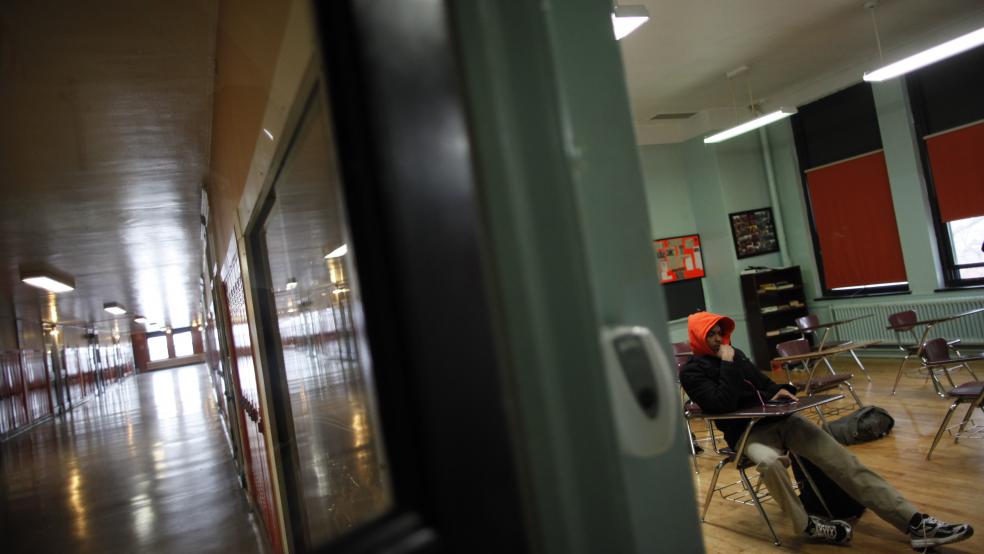Researchers have examined the inequities between city schools districts and also evaluated the performance of urban charter schools. What they haven’t been able to do is a take a comprehensive city-by-city look at public and charter schools together—until now.
“If you're a city leader—a mayor or some other community leader—it's hard to gauge the overall health of the city schools. That can make it hard to frame where the city's doing well, and where it needs to do better,” says Michael DeArmond, senior analyst at the University of Washington’s Center on Reinventing Public Education, and lead author of CRPE’s new study that seeks to plug this hole in education data.
Related: The 10 Best and Worst Cities for Police, Schools and Parks
In the report, DeArmond and his colleagues analyzed recent federal and state data on public and charter schools in the 50 cities with the highest school enrollment. Their measures included test scores, graduation rates, and even suspension rates for students by race. The resulting portrait of the city public school system in the U.S. is “discouraging,” DeArmond says.
CPRE summarizes the findings on its site:
Our analysis shows some brights spots, but performance in most cities is flat. Poor and minority students face staggering inequities, and the picture is especially bleak for black students.
Most city public schools aren’t improving
Across all 50 cities, the average graduation rate was around 75 percent. This varied widely from one city to another. While Toledo, Ohio, saw just slightly over half of their public school students graduate, Fort Wayne, Indiana, reached a 90 percent graduation rate.
Related: Ten Best Cities for Jobs
In terms of testing, less than a third of the cities analyzed in the report improved their math and reading scores relative to the state average. Only 12 cities saw gains in math scores (below, left) while 14 saw improvements in reading (below, right):

The report also looked into whether each city’s lowest-performing schools (defined as being in the bottom 5 percent of state school performance) made improvements. Across all cities, 40 percent of these bad schools remained stuck in the state’s lowest-performing band.
There were some exceptions. In New Orleans and Washington, D.C., no low-performing school stayed in that bottom band for the three consecutive years analyzed. In NOLA, post-Katrina school reform led to the closure of several low-performing public schools. In D.C., these results reflect a spotty but significant improvement.
Low-income and minority kids are still at a disadvantage
In a majority of the 50 cities, low-income and minority students were less likely to attend high-performing elementary and middle schools, take advanced classes, and take the ACT or SAT tests than higher income and white kids, respectively.
Related: The Education Department Is Failing Students Who Got Defrauded
The performance gap between low-income students (taken here as kids eligible for free or reduced priced lunches) and other kids was a stark 14 percentage points overall. These achievement gaps were particularly wide in cities like Denver, Cleveland, and Raleigh, the report finds.
Here’s a chart of percentage point difference between low-income and other students in math and reading scores by city:

Hispanic and black students faced the most disadvantages, even in places where they made up the majority of public school students. In Phoenix, Hispanic students were four times as likely as white students to be enrolled in schools that have low math scores. In L.A., they were seven times as likely. It’s the same story for majority-black public school students in Newark: only 6 percent of them studied at top-scoring math schools, compared with 85 percent of white kids.
The need for new solutions
These findings support what the CRPE has been saying for a while: when it comes to improving the school system for all students and ending academicsegregation, city policies matter. Here’s how Robin Lake Director, CRPE’s director, puts it in the report’s introduction:
Rather than be distracted by dogfights over Common Core, testing, choice, teacher evaluations, charter schools, and other policy debates, our city school system leaders need to aggressively hunt for and be open to new solutions, and respond quickly and meaningfully to shifting demographics and other challenges.
This article originally appeared on City Lab. Read more from City Lab:
Yet Another Awful Design for Airline Seating
Flint Is Finally Getting a Reprieve From Its Tainted Water Supply
How To Keep [Your City] Weird



